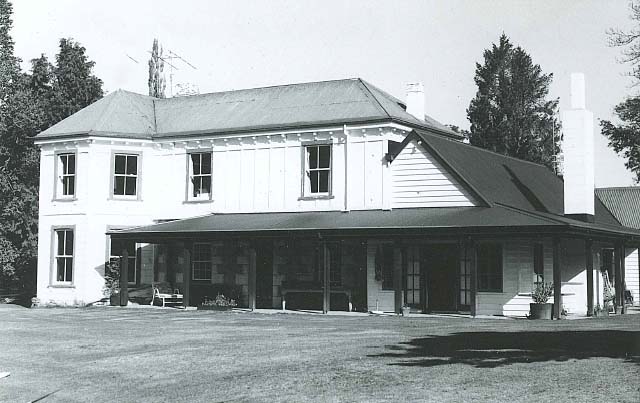Clayton Homestead was built over several decades on the Clayton run in South Canterbury. The station on which it was built originally consisted of two runs, one being Run 331, which was taken up in 1860 by a partnership of the Kennaway brothers, (William, Laurence and Walter), Edward Acton and a person known only as Lee. The second was Run 370, which the Kennaway brothers acquired in October of the same year. The Kennaways stocked the two runs in 1861-1862 and a description of their exploration and stocking of Clayton can be found in Laurence's book 'Crusts'. Unfortunately, the Kennaways lost most of their sheep in the crippling winter of 1862. The following summer they sold the station to the partnership of Walker and Clogstoun, who owned the neighbouring station, Fourpeaks. Walker and Clogstoun comprised the two Walker brothers, Lancelot and Sherbrooke, and Captain Edward Louis Clogstoun. Both Fourpeaks and Clayton stations were let to George Arthur Emilius Ross and Charles John Harper, son of Henry John Chitty Harper, the first bishop of Christchurch. In 1867 Ross and Harper were also ruined by a bad winter and the runs reverted to Walker and Clogstoun. Clayton was worked as a separate station, with its own flock and overseen by the head shepherd. It appears that the first part of the Clayton homestead, the substantial stone cottage, was built during Walker and Clogstoun's ownership of the property, in the late 1860s and early 1870s. The cottage had two ground-floor rooms and two attic bedrooms lit by dormer windows. The quoins, doorways and window surrounds were constructed from a lighter limestone. The quality of the stone in South Canterbury had been noted by Julius Haast in a report to the Canterbury Provincial Council in 1864 and it was often used for building throughout the region. Originally the cottage was thatched with snowgrass. In 1881 Clayton was bought by Hugh Hamilton (?-1900), an Australian who placed his two sons, George and Dundas, in charge of the station. At the time of the purchase the run carried around 19,000 sheep. Clayton remained in the Hamilton family until 1919. They experimented with crossbreeding Merinos with Border-Leicesters but after 1914 moved to stocking Corriedales (New Zealand's early contribution to sheep breeding). Their flock peaked at 30,000 sheep. Hamilton removed the attic rooms of the stone cottage and built a board and battern addition on top of it. He later added a single storey kitchen building to the cottage and then a two-storeyed block to the east end of the homestead. In 1917 some of the run was taken over for closer settlement and the Hamiltons sold over 14,000 sheep. After 1919 the station was sold to a syndicate and in 1925 it passed to Simon Mackenzie who purchased Clayton for his sons. They remained at Clayton until 1964. It appears that no major changes to the homestead took place during this time. In 1967 the station was taken over by Andrew and Ruth Orbell and they added to the homestead in 1982. The Orbells' extension wraps around the west wall and part of the rear of the original stone cottage so that the original exterior wall now forms the inside corner of an 'L' shaped room. Clayton Homestead is a significant example of the way in which station homesteads often evolved. Rather than demolishing the earlier buildings when the homestead needed to be expanded, the owners of Clayton incorporated the old with the new and built around the earliest parts. Clayton thus retains an example of the early stone homesteads typical of South Canterbury within it and overall the nineteenth and twentieth century additions have been sympathetic to the simplicity of the original structure. Clayton Station was one of the important South Canterbury sheep runs and it is historically representative of the large pastoral holdings which established Canterbury as one of the leading wool and lamb producing provinces of New Zealand.

Location
List Entry Information
Overview
Detailed List Entry
Status
Listed
List Entry Status
Historic Place Category 1
Access
Private/No Public Access
List Number
310
Date Entered
9th September 1984
Date of Effect
9th September 1984
City/District Council
Mackenzie District
Region
Canterbury Region
Legal description
RS 14214 (RT 129507), Canterbury Land District
Stay up to date with Heritage this month
